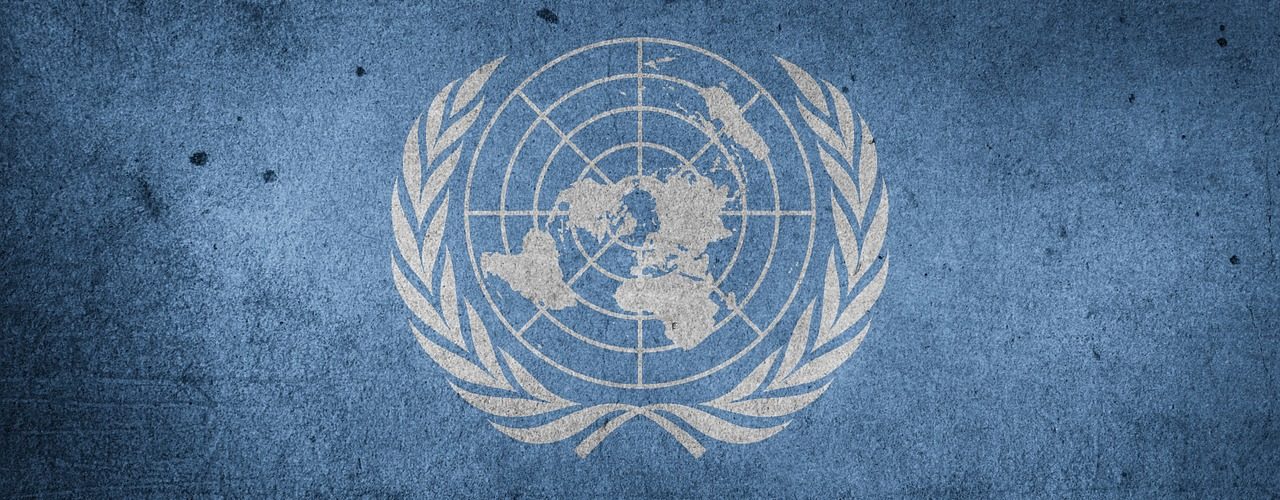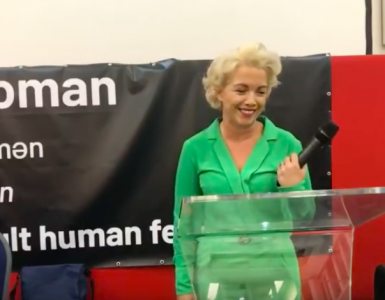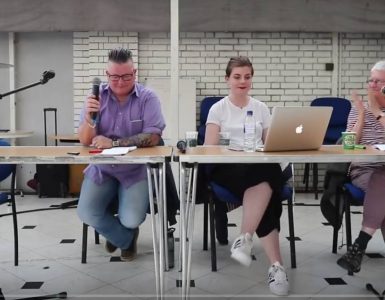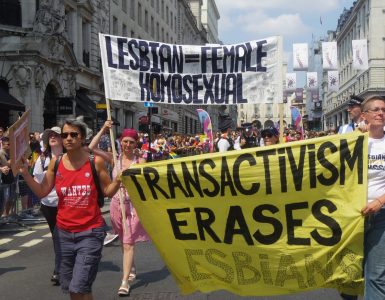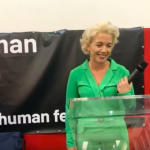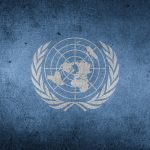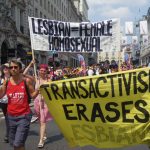Sheila Jeffreys We Need to Talk Event June 2018 London
Download PDF
Why International?
I am going to talk today about why it is important to think internationally when dealing with the threat posed by men’s crossdressing activism (commonly called the transgender rights movement) to women’s human rights. In the UK the feminist resistance has been growing exponentially in the last year to excellent effect. But we have concentrated on the UK manifestation of crossdressing rights. We have been looking at the tip of the iceberg and not noticing the growing, powerful international men’s sexual rights movement that supports what trans rights activists are demanding in this country. There is a huge international human rights campaign backing this local trans rights activism featuring powerful individual and corporate donors, a range of very influential human rights organisations, many dedicated entirely to trans rights internationally, and a variety of important documents making statements about trans rights that do not yet have any force in law but are increasingly recognised internationally as human rights best practice
To show how far along the gender rights agenda has come, in March this year the EU parliament adopted a report on Fundamental Rights in the EU which condemns states which require any kind of medical evidence to support change of ‘gender’, called ‘psychiatric consent’, and argues for depathologisation of transgenderism and self-identification (European Parliament, 2018). In other words, it condemns the UK 2004 Gender Recognition Act and calls for change to enable self-identity legislation. It states that what it calls ‘transgender people’ do not have a mental illness but requires that these people should have easy access to medical treatment such as surgery. This does not yet have legal weight, it has not been changed into a directive, but this could happen very quickly, and we will know nothing about it because we do not get information about such changes in the UK, no consultation just fait accompli.
Such developments, which are happening thick and fast and mostly without the knowledge or scrutiny of feminists, are based on the Yogyakarta Principles. The 2007 Yogyakarta Principles, which were updated in 2017 with 10 extra principles called the Plus, were promulgated at a meeting in Indonesia. They are signed by a range of heavyweight human rights campaigners, lawyers and functionaries. The signees include some significant feminist human rights campaigners and I suspect that these women signed because the Principles constitute a charter of human rights for lesbians and gay men. They are unlikely to have known the implications of the whole half of the principles which relates to gender identity, or may, as many people do, assumed that this was something to do with gayness and with no particular implications for women.
The section of the Principles which relates to gay rights is a very important and necessary development, much lauded by lesbian and gay rights activists and others in the human rights community. The problem with the Principles, however, is that they yoke together lesbian and gay rights with the right to protection and expression of something called ‘gender identity’ and call for the protection of gender rights. Gender is the opposite of sex. Sex is biology and it is on the basis of biology, that women are oppressed, and on the basis of biology that women have gained rights and become a protected category in some jurisdictions. The notion of ‘gender identity’ explodes all of this and endangers the very notion of women’s rights as human rights ‘Gender identity’ rights are the triumph of a couple of decades of campaigning by men who crossdress for sexual excitement who have managed to Sellotape their sexual interests onto the rights of lesbians and gays.
The idea of ‘gender’ arises from the oppression of women. Gender comprises the behaviour and appearance norms required of men and women. Femininity is the enforced behaviour of the oppressed, that is women, and includes humiliating clothing norms of high heels, depilation and body exposure or body covering, the restriction of body movement, taking up little space. It is based upon the false idea that women’s brains are somehow different from those of men in ways which make them suited to such appearance and behaviour and make them rightfully subordinate and more suited to doing housework. Masculinity is the behaviour of the powerful, and includes taking up space, the expression of confidence and control of boundaries in the form of striding, wearing dignified clothing, and not cleaning the toilet. Gender comprises the behaviour of two groups of people in a hierarchy of oppression, the subordinates, women, and the dominants, men. The notion of ‘gender identity’ makes ‘gender’, i.e. the behaviours of a system of oppression, into something natural and inevitable. It eradicates the 5-decade feminist struggle to eradicate ‘gender’, which was previously, and I think more clearly, called ‘sex roles’ and meant who did the housework and chivalry etc.
The Yogyakarta Principles do not have any force in law but they, and their notion of ‘gender’ are increasingly very influential in international law, though most feminists probably have no idea that they exist. They arise from a campaign by crossdressing men to protect and promote their masochistic sexual obsession.
Transgender rights
I have called this talk the protection of men’s sexual rights in international law because the idea of what are now called transgender or gender identity rights came from men with a sexual interest in crossdressing. Crossdressing, which has also been called transvestism, is what is called in sexology, the so-called science of sex, a paraphilia. Paraphilias are more commonly called sexual perversions when not being discussed ‘scientifically’. Men who crossdress are masochists who are sexually excited by impersonating what they see as the subordinate class i.e. women. Their extensive pornography and support sites online make this clear. Some brave sexologists who are prepared to face the vicious abuse they receive for their scientific analysis, say this too and provide a great deal of evidence from their years of clinical work with these men.
There is plenty of evidence of the sexual motivation for men’s crossdressing behaviour. Ten percent of porn is transgender erotica, all directed at satisfying the sexual desires of crossdressers to experience the humiliation of being feminised, most often forcefully or by accident, as in the story entitled ‘Gender Swapped by Aliens’ for instance. There is evidence too on the websites that sell men lycra women’s body suits or body parts to masturbate into. The fetishistic aspects of crossdressing are obvious in the interest these men have in pretending to menstruate. TG discussion boards address whether pads or tampons are better. Some men put red substances on the pads they wear to be more realistic. This is ‘gender identity’, i.e. the eroticising of women’s subordination, the protection of which is now promoted as human rights best practice. It is male crossdressers who have campaigned for gender rights. The Lesbians, and the women who are transgendered are almost entirely lesbians, who are straightened out by the brutal drug regimes and surgeries of transgenderism and the children who are severely harmed, the vast majority of whom are girls who are as the sexologists say ‘same sex attracted’, are collateral damage of what is overwhelmingly a men’s sexual rights movement.
History of crossdressing
Men’s crossdressing for sexual excitement has a long history, but before the second half of the twentieth century these men did not say they were really women. They mostly crossdressed at special parties or on crossdressing weekends, or in secret. The development of hormones and surgical techniques, and the idea promoted by psychiatrists, endocrinologists and surgeons, that sex could actually be changed, encouraged some men to think they could become women. The medical profession developed the idea of sex change particularly to cure homosexuality, because psychiatrists believed that homosexual men must somehow really be women and have women’s brains in men’s bodies. The first man who underwent the full treatment in the US was a homosexual, who called himself Christine Jorgensen. Crossdressing activists started to organise together in support organisations in the 1960s and 1970s, the Beaumont Society in London for instance. In the 1990s the development of the Internet enabled the creation of a political movement of crossdressers who created a charter of rights, asserting their rights to be recognised legally as women and access all spaces and resources assigned to women.
International Bill of Transgender Rights
The desires of these crossdressers were set out in 1995 by a group of men in the US and titled the International Bill of Transgender Rights. It was just a wishlist as to how they would like their sexual fantasies to be accommodated and protected by the state. It had of course no standing in law and may have seemed outlandish to many at the time, but these men’s demands have now been incorporated in domestic law in many countries and are being campaigned for with considerable success in international fora through the vehicle of the Yogyakarta Principles.
The man who claims to have ‘authored’ the original Bill of Gender Rights in 1990, which was the basis of the International one, calls himself JoAnn Roberts. He is an occasional crossdresser and does not claim to be a woman, ‘I’m a crossdresser, divorced and remarried with two adult children’ (Jeffreys, 2014): 143). He organises crossdressers’ weekend getaways. Another main figure in creating the Bill is the very masculine man who pretends to be a woman and calls himself Phyllis Frye. He was very successful as a man and reels off his credentials in the cadet corps and the US army (Ibid).
The first ‘right’ in the Bill states that ‘all human beings have the right to define their own gender identity regardless of chromosomal sex, genitalia, assigned birth sex, or initial gender role’. The other rights concern these men’s posturing as women in public spaces and women’s spaces and their right to cosmetic surgery to acquire their desired body shape. The International Bill of Transgender Rights provided the template for what became, 10 years later, the gender identity rights section of the Yogyakarta Principles. The coup the crossdressers were able to accomplish in the intervening years was the piggybacking of their sexual fetish rights onto the rights of lesbians and gay men so that crossdressing rights came to be seen as similar to lesbian and gay rights and inseparable from them.
How the Yogyakarta Principles create a clash with women’s rights
The definition of ‘gender identity’ in the YPs replicates the template that the American crossdressers created in the 1990s. It is founded on the notion that something called ‘gender’ is not an oppressive social construction that is imposed as the basis of male domination, but some kind of natural or innate condition:
[2] Gender identity is understood to refer to each person’s deeply felt internal and individual experience of gender, which may or may not correspond with the sex assigned at birth, including the personal sense of the body (which may involve, if freely chosen, modification of bodily appearance or function by medical, surgical or other means) and other expressions of gender, including dress, speech and mannerisms (Yogyakarta Principles).The definition by including dress, speech and mannerisms, clearly includes such things as hair-flicking, mincing steps, camp language and behaviour. I have discovered from Ask Men, and online site, that hair flicking is a way in which women show sexual interest in men. I never, even when heterosexual and with long hair, knew this. How is any of this in the interests of women? Hands up who in this audience thinks that they have a gender or wants to be protected in their expression of it? Do I do gendered mannerisms for instance. If I put my hands in my pockets and do not carry a handbag, am I then doing masculine gender identity? It is shocking that something so vague, something so insulting to women, should form part of what purports to be a serious human rights document. But there are no critics of the YPs. All commentary extolls them and is completely laudatory. They are seen as a triumph.
The right to the protection and expression of gender identity includes men who adopt mincing steps to imitate women’s supposed way of walking, who speak in a high voice and engage in hair flicking and other supposedly feminine behaviours. These gender expressions consist of precisely those gender stereotypes that women and feminists seek to abolish. The YPs seek the protection of these stereotypes as acted out by men for sexual purposes in international and national legal systems.
We are in this dire situation where lesbian and gay rights and ‘gender identity’ rights are inextricably yoked together in a document which is extremely influential and increasingly seen as best practice by governments and other assemblies. The YPs and all the instruments that arise from them state that ‘gender identity’ should be self-defined. Whilst many states such as the UK have legally recognised the right of persons to change their ‘gender’, whatever that is, on the basis of certain criteria such as recommendations by doctors and a ‘real life test’ of living in the chosen ‘gender’ for a period of time, the YPs demand that states go further and allow applicants to self-identify. This means that any man who crossdresses on the weekend, say, or makes no changes to his appearance and retains both penis and beard, can be legally recognised as a woman if he demands this. As one example, it is being cited in the projected new legislation in Scotland which will allow men to self-identify as women, as justification. The document from the Scottish government about their proposals to change the requirement for ‘gender’ recognition certificates specifically states:
3.10.The view of the Scottish Government is that the 2004 Act requirements are unnecessarily intrusive and do not reflect the best practice now embodied in the Yogyakarta Principles and Resolution 2048 (Scottish Government,2017).
The extent to which the YPs are now embedded in international law is evident in the adoption in the other document that the Scottish Government references in their support, Resolution 2048, adopted in 2015, by the Parliamentary Assembly of the Council of Europe. PACE resolutions do not have the force of law in the EU but resolutions do usually get adopted by the EU in time. It is specifically about protection of what it calls ‘transgender people’ from violations of rights but states that ‘The Assembly welcomes, in this context, the emergence of a right to gender identity’, and supports self-identification of ‘gender’ without complex procedures.
The influence of the YPs at the UN is clear in a 2016 resolution of the Human Rights Council (United Nations, 2016). The resolution entitled: Protection against violence and discrimination based on sexual orientation and gender identity (adopted 30 June 2016). This established the position for a period of 3 years, an Independent Expert on the protection against violence and discrimination based on sexual orientation and gender identity. There are no definitions in the resolution, so it is hard to know what they understood gender identity to mean and of course no recognition that there is any controversy over the term.
Lesbians rights and gender
As a lesbian feminist I am extremely aware of the need for the protection of the rights of lesbians and gay men internationally. The rights of lesbians and gays need to be separated off from the rights of heterosexual male crossdressers if the rights of lesbians and all other women are to be protected. The YP as far as they concern lesbian and gay rights are much needed and it is very unfortunate that they are compromised and undermined by the creation of rights for mainly heterosexual men who crossdress and impersonate women.
But the definition they give of the lesbian is extremely problematic and one which very many lesbians would fundamentally disagree with. Lesbians are defined as: ‘Women who sexually, physically and romantically feel attracted to individuals of the same gender’. Gender is a social construction which underpins male dominance. Lesbians are not attracted to women because they are ‘feminine’, i.e. wear makeup and walk with small steps, but because they are women. The YP definition of the lesbian is extremely destructive to lesbian pride and lesbian rights. It supports the notion that a man who says he has the gender identity of a woman can claim to be a lesbian and demand sex from lesbians.
The YPs are completely contradictory and confusing in the way in which they employ the word ‘gender’. When placed in front of the word ‘identity’ it means any person’s belief that they have some essential personality traits normally found in the other sex. When employed to describe lesbians above, it probably means ‘sex’ but this is absurdly unclear. Nonetheless this absurdity is now the definition of a lesbian that is being used in international law.
Lesbian and gay rights and the UN
The Yogyakarta Principles were the result of decades of campaigning for the recognition of lesbian and gay rights in international law. There was no chance that our rights would be created into a United Nations convention because powerful blocks of nations such as the muslim countries and strictly catholic ones would never allow that. I attended the 2000 CEDAW Convention on the Rights of Women conference in New York. It was called Beijing Plus 10 because it was 10 years after the groundbreaking 4th World Conference on Women in Beijing conference out of which came the Beijing Declaration and Beijing Plan for Action. This was the apogee of feminist human rights activism. At the 2000 CEDAW conference, Christian Churches and Islamic organisations mounted a determined fightback and made it clear that they would prevent any further progress on women’s rights. Thus, the issues to which they were most opposed, abortion rights and gay rights never entered any conventions and were never going to.
Plus, these organisations were relentlessly opposed to any use of the term ‘gender’. Catholic schoolboys were mobilised by clerics in medieval costume in the corridors of the UN building to pursue members of a young lesbian and gay group that wanted to meet and to disrupt them. I went to a meeting on lesbian and gay rights and was in an audience backed by horrified schoolboys with highly polished shoes doing their rosaries as gay rights were discussed. The religious took over a conference which in previous years had scarcely had any men or boys in attendance. To participate in UN proceedings, organisations must have accreditation by ECOSOC, the UN’s Economic and Social Council. Lesbian and gay rights organisations were not allowed accreditation. This changed in December, 2007, when ECOSOC allowed lesbian and gay organisations to be accredited so that they could attend CEDAW. This should have been a cause for celebration except that all campaigning for lesbian and gay rights now includes the rights of men who crossdress and pretend to be women, i.e. men who directly contravene women’s human rights through impersonation.
The opposition within ECOSOC and UN fora generally meant that lesbian and gay organisations campaigned outside UN fora to create an instrument that could be used to apply pressure internationally in and between countries, and that would have some moral force though it would not have the force of a convention. The creation of the YPs was politically very astute as far as lesbian and gay rights are concerned. The problem arose when ‘gender identity’ was sellotaped onto gay rights with no explanation. It is as if it is obvious why the two issues should be connected so that no comment needs to be made upon it. It is not possible now to campaign for lesbian and gay rights without also promoting the notion and practice of ‘gender identity’ and the rights of fetishistic crossdressers. We need to understand how this extremely problematic linkage came to pass.
What is the connection between sexual orientation and gender identity?
The YPs and the many documents that have stemmed from them entwine sexual orientation and gender identity so closely that one short acronym which incorporates both has been developed and is now wielded in human rights campaigning, SOGI. SOGI means ‘sexual orientation and gender identity’ and is sometimes used in its plural form SOGIES. It is now no longer possible to campaign for lesbian and gay rights without automatically triggering the promotion of ‘gender identity’ rights. As the International Service for Human Rights, one of the major NGOs that campaigns for gender rights explains:
The phrase ‘SOGI’ now rolls off the tongue quite easily. Yet, before the Yogyakarta Principles were formulated, the language in international law focused solely on sexual orientation (International Service for Human Rights, 2016).
This is a tremendous blow to lesbians who badly need human rights protections. To give but one example, lesbians in South Africa are relentlessly raped and murdered in a state that ignores any responsibility. Right now, we cannot campaign to support them without also promoting the rights of heterosexual crossdressers to take over women’s spaces and opportunities, and to pretend to be ‘lesbians’ and pressure lesbians to allow penile access.
It is not lesbians who have dominated campaigning for gay rights but gay men, so the question is why gayness and gender identity have been wrapped up together in this extremely unfortunate way. Historically, gay men have been understood culturally and by the sexologists, the scientists of sex, from the 19th century onwards, as having the brains of women in the bodies of men. They have been seen as socially subordinate and for sexual use by other men as women are. Gay men have pretended to be women as comedy acts to entertain their peers in gay clubs and bars for decades. Drag is a perennial feature of male gay culture. There is no such tradition in lesbian culture though some lesbians tried to invent something called dragkinging in the 1990s. This historical association may have led to gay men themselves or the general public making a link between ‘femininity’ and homosexuality.
The old canard that homosexuality was a result or manifestation of men and women having the brains of the opposite sex mysteriously transplanted into their bodies was fiercely rejected by the gay liberation movement and lesbian feminism. But these movements declined and drag did not. In countries all over the world there has never been any challenge to the idea that gay men are somehow female or feminine. I suspect that it is for these reasons that the men campaigning for gay rights have wedded themselves to transgender rights. These gay men recognise that many of their community see themselves as failed men, reduced to the status of women, and wish to support them.
The International Service for Human Rights, has explained why ‘sexual orientation and gender identity’ have been ‘placed’.. ‘on the same plane’. It is because of ‘LGBT defenders from the global south for whom such an inclusion was a non-negotiable’ (International Service for Human Rights, 2016). The protection of gay rights, in countries in which there is severe harassment of gay men and no concept of gay pride, could be seen as requiring the protection of crossdressing because so many gay men, particularly those in prostitution, do this. There was no consideration of the implications of the promotion of gender identity rights for the rights of women. Women were simply not in their field of vision, only drag queens.
American imperialism
Since the 1990s, the concept of transgenderism has been promoted internationally through NGOs working on issues such as HIV/AIDS and gay rights. It has been used to refer to men who are prostituted by other men in both the US and in other countries. In many countries where men who want sex with men like to consider themselves heterosexual, men and boys who are feminised for their sexual use in prostitution. These include drag queens in NY city, hijras in India and Lady Boys in Thailand. Until the 1990s and in some cases not til now, these men did not see themselves as women, they knew they were gay men and had no wish to divest themselves of their penises. The Western, and specifically American concept of transgenderism has now become the accepted language internationally and has the effect of forcing into surgery and terrible medical interventions, persons, including now some lesbians, who had never previously entertained the notion that they were really of the opposite sex. NGOs working on gay issues are now required to promote transgenderism in order to get access to funding from western donors.
Who campaigns for gender identity rights?
The many NGOs campaigning for gender identity rights are influential and well-funded with impressive and professional websites. The groups that campaigned for the YPs originally included, alongside ISHR, the Harry Benjamin International Gender Dysphoria Association (HBIGDA). This group met regularly from 1979 and was composed of psychologists, physicians, and other care givers, largely from and associated with Johns Hopkins University in the USA which abandoned the performance of sex change surgery in 1979 because it was considered not to be efficacious. Others include ILGA, the International Lesbian and Gay Rights Association, and ARC International, which started in Canada, now has an office in Geneva and works specifically on lesbian and gay rights and gender identity. ARC was influential in creating the YPs and boasts about its influence at the UN and now at CEDAW where it will be changing language and understandings around the protection of women’s human rights to facilitate men’s sexual rights. These organisations have funding and clout which is simply not available to any women’s or feminist groups. Most lesbian and gay organisations now concentrate very much on trans rights because that is what they can get funding for, despite the fact that the transgendering of gay men, and lesbian girls and women is a profound and horrifying form of violence.
The suppression of women’s and feminist speech
The YPs seek the suppression of women’s and feminist speech. They call upon States Parties to ‘Take all appropriate action’ to achieve ‘the elimination of prejudicial or discriminatory attitudes or behaviours which are related to the idea of the inferiority or the superiority of any sexual orientation or gender identity or gender expression’. This would make the expression by a woman of her opinion that she was more of a woman than a man in a dress was, into a form of potentially actionable prejudice. It augurs ill indeed for the sort of free speech we, as feminists, are demanding and expressing at this meeting for instance.
Plus 10
The YPs have been influential in creating a new language, and thus a new way of thinking about, human rights. Women’s human rights are based upon recognition of the category of ‘sex’. This is the sine qua non of the so-called women’s convention CEDAW. The introduction to the Convention states, for instance:
Altogether, the Convention provides a comprehensive framework for challenging the various forces that have created and sustained discrimination based upon sex.
The YPs substitute gender, the male fetishistic understanding of what women are, for the term sex and thereby eliminate any protections for women as an oppressed class of persons based upon biological sex. When they were updated in 2017 with something called the Plus 10, the language became even more peculiar and exclusionary towards women and women’s rights. These new principles show that the demands of crossdressing men had became more extreme in the intervening years. The Plus 10 includes, for instance, the demand that sex, the biological basis for women’s oppression, be eliminated for official documents. They call for an end to ‘the registration of the sex and gender of the person in identity documents such as birth certificates, identification cards, passports and driver licences, and as part of their legal personality’ (31) (Yogyakarta Principles, 2017). This eliminates the sex class of women and the possibility of recording any information relating to discrimination against women and violence against us. If sex cannot be mentioned, then woman as a category is disappeared and feminism and the idea of women’s rights cannot exist.
Sex characteristics
Though the Plus 10 want to eliminate the significance of biological sex, they found it necessary to introduce another peculiar concept which supports the notion that biology does, inconveniently, exist, but has nothing to do with making people men or women. They include a new term ‘sex characteristics’, which is used throughout, and does not occur in the original 2007 Principles. This term is added to the other categories that the YPs seek to protect, notably ‘sexual orientation, gender identity and expression and sex characteristics’. These are defined as:
Sex characteristics (SC) – Include primary sex characteristics (eg, inner and outer genitalia and/or the chromosomal and hormonal structure) and secondary sex characteristics (eg, muscle mass, hair distribution and stature).
The reason for this inclusion is not explained but it is not anything to do with the rights of lesbian and gays so must serve the interests of male crossdressers. It would, for instance, protect men who claim to be women or lesbians despite their bodies remaining physically unchanged. Thus, men’s penises can become, as they are in transgender porn, ‘lady sticks’. The inclusion of this term prevents women from making the inconvenient complaint that the female impersonators in their toilets or changing rooms have penises. The old fashioned term ‘sex’ was the basis of women’s rights, the term ‘sexual characteristics’ is necessary to protect cross-dressing men in their predilection.
The Plus 10 also went further than the original principles in emphasising and giving more detail to the demands by male crossdressers to take over women’s spaces and opportunities. There is more detail, for instance, about the way in which men must be included in women’s sports. This demand is specifically about men’s rights. There is no demand by women who transgender to enter men’s sports as they would gain no material advantage and would be likely to lose. Men entering women’s sports have male physiology which makes them hugely stronger as well as larger. Mediocre men or those past their best, have a real chance of competing successfully against women and they are determined to gain this advantage.
Another way in which the Plus 10 go further is in including ‘surrogacy’ under the ‘right to found a family’. The right to traffic in babies and use women in reproductive prostitution has gained more and more acceptance as a result of gay men’s taking up and promoting this commercial baby market. The embracing of ‘surrogacy’ makes it clearer that the Principles are about men’s rights and against women’s rights.
Conclusion
Women rights are being overthrown or subject to challenge in such a whirlwind and significant way at the moment that it is urgent we work out how fight back. What is the best way to challenge this international takeover by men’s sexual rights of the human rights sphere? The trans rights organisations are attending CEDAW presently to fight for their language and interests. One thing women must do is be there. This means getting into a women’s organisation that already challenges trans rights, and not many do, and is a recognised NGO able to send representatives to CEDAW or setting up our own organisations so that we can apply for recognition and go there to challenge the trans push. This is expensive. Travel and accommodation in NY cost a lot of money and all the well-funded trans and gay organisations find this no problem. It will be a problem for us, but we need to get there. In Europe, I suggest, we need to be lobbying MEPs, and the women’s group in the European Parliament and the European Women’s Lobby.
References:
European Parliament (2018, 13 February). REPORT on the situation of fundamental rights in the EU in 2016 (2017/2125(INI). Committee on Civil Liberties, Justice and Home Affairs. Rapporteur: Frank Engel http://www.europarl.europa.eu/sides/getDoc.do?pubRef=-//EP//NONSGML+REPORT+A8-2018-0025+0+DOC+PDF+V0//EN
International Service for Human Rights (2016). The Yogyakarta Principles on Sexual Orientation and Gender Identity: Establishing the Universality of Human Rights. https://www.ishr.ch/news/yogyakarta-principles-sexual-orientation-and-gender-identity-establishing-universality-human
Jeffreys, Sheila (2014). Gender Hurts: a feminist analysis of the politics of transgenderism. London: Routledge.
Parliamentary Assembly (2015). Discrimination against transgender people in Europe. http://assembly.coe.int/nw/xml/XRef/Xref-XML2HTML-en.asp?fileid=21736
Scottish Government (2017). Review of the Gender Recognition Act 2004. Part 3. Reforming the legal gender recognition system in Scotland. http://www.gov.scot/Publications/2017/11/5459/347288
United Nations, Office of the High Commissioner for Human Rights (2016). Independent Expert on sexual orientation and gender identity
Yogyakarta Principles Plus 10 (2017). https://yogyakartaprinciples.org/
